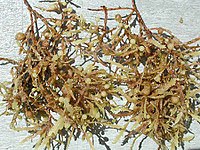
Photo from wikipedia
Reefs at Ko Samae San (S), Khao Ma Cho (K) and Ko Tao Mo (T), in the Gulf of Thailand represent a biodiversity hotspot, and bacteria play significant roles in… Click to show full abstract
Reefs at Ko Samae San (S), Khao Ma Cho (K) and Ko Tao Mo (T), in the Gulf of Thailand represent a biodiversity hotspot, and bacteria play significant roles in maintaining the health of these coral reefs and their biogeochemical cycles. Therefore, this study analyzed bacterial communities (microbiota) from healthy corals and nearby seawater and sediment, using B-RISA and 16S rRNA gene sequencing. Sampling was done in one dry and one wet season to provide an initial assessment of variation with environmental conditions. The most prevalent coral species were Porites lutea, Platygyra sinensis, Acropora humilis and Acropora millepora. The B-RISA and the sequencing results were correlated, which increased confidence the results. The microbiota varied among corals, seawater and sediment and between the wet and dry seasons. Percentages of bacteria with known functions varied among sample types and seasons, and their relative abundances supported previously reported essential functions, such as prevention of disease (e.g. Pseudoalteromonas, Psychrobacter and Cobetia were more abundant on corals in the dry season). Pearson's correlations and multiple factor regressions identified dissolved oxygen, temperature, salinity and density as significant influences on the microbiota. The equations estimated the relative abundance of a community comprising 147 bacterial genera, as well as the relative abundance ofPseudomonas, Clostridium, Verrucomicrobium and Epulopiscium (R2≥0.721). These results represent the first descriptions of microbiota from corals, and surrounding seawater and sediments in the upper Gulf of Thailand.
Journal Title: Frontiers in Marine Science
Year Published: 2018
Link to full text (if available)
Share on Social Media: Sign Up to like & get
recommendations!